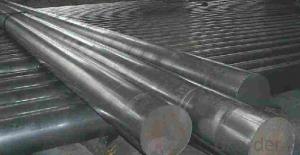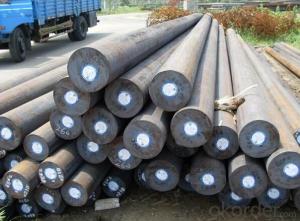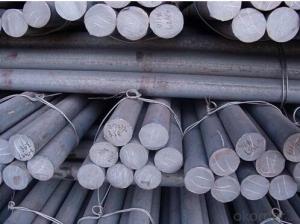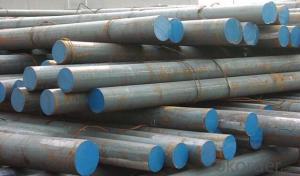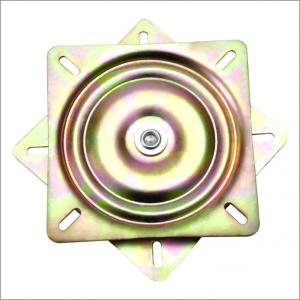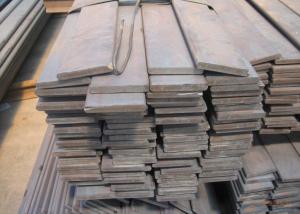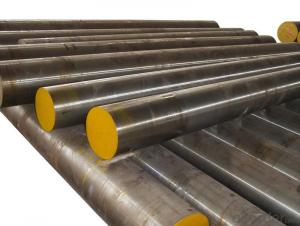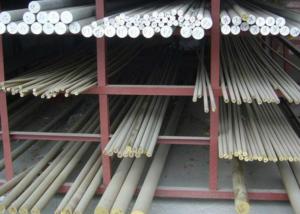Grade DIN34CrNiMo6(1.6582) Alloy Steel Round Bar
- Loading Port:
- Shanghai
- Payment Terms:
- TT OR LC
- Min Order Qty:
- 30 m.t
- Supply Capability:
- 10000 m.t/month
OKorder Service Pledge
OKorder Financial Service
You Might Also Like
Item specifice
Specifications of Round Bar
1. Alloy steel round bar
2. Dia:16mm~250mm
3. Length: 6m, 9m, 12m or as customer’s request
4. Tolerance: Within ±5% for weight; ±2mm for diameter
5. Note: The price can be better is the quantity is good
6. Equivement Grade:
DIN:34CRNIMO6
SAE:4340
JIS:SNCM439(SNCM8)
BS:817M40
UNI:40NiCrMo7
2. Chemical Composition
| C | Si | Mn | S | P | Cr | Ni | Cu | Mo |
| 0.37-0.44 | 0.17-0.37 | 0.50-0.80 | ≤0.025 | ≤0.025 | 0.60-0.90 | 1.25-1.65 | ≤0.025 | 0.15-0.25 |
Mechanical Property
Tensile Strength: σb (MPa):≥980(100)
Yeild Strength: σs (MPa):≥835(85)
Elongation: δ5 (%):≥12
Impact Force: Akv (J):≥78
Usage and Applications of Round Bar
1. Chinese standard steel bar is often used where large amounts of steel need to be formed, for example as structural steel.
2. And we can use this kind of product on the performance of the mechanical parts if the demand is not very high.
3. Steel round bar is used in construction and a large number of architectural and engineering structures.
Packaging & Delivery of Round Bar
Packaging Detail: All goods are packed in bundle with steel strips and shipped by break bulk vessel or container (depend on target market and different ports)
Delivery Detail: 15~45 days
Trade terms: FOB, CFR, CIF
MOQ: 30 metric tons per specification; we can negotiate the quantity if the specification is normal or we have stock of one specification.
Weight: Theprice invoicing on theoretical weight basis or actual weight basis depends on customer’s request.
Shipment: The shipment of bulk break or container is depends on customer’s request and the situation of the port of destination.
Documents given: Full set of original clean on board bill of lading; Original signed commercial invoice; Original packing list; Policy of insurance; Certificate of origin and what the target market needs.
Production Flow of Round Bar
1. The common processes are preheated forging quenching, dual refinement solution process, cooling quenching and isothermal quenching. We use heat treatment for dual refinement solution process.
2. Material prepare (billet) — heat up — rough rolling — precision rolling — cooling — packing — storage and transportation
FAQ:
Q1: Why buy Materials & Equipment from OKorder.com?
A1: All products offered byOKorder.com are carefully selected from China's most reliable manufacturing enterprises. Through its ISO certifications, OKorder.com adheres to the highest standards and a commitment to supply chain safety and customer satisfaction.
Q2: How do we guarantee the quality of our products?
A2: We have established an advanced quality management system which conducts strict quality tests at every step, from raw materials to the final product. At the same time, we provide extensive follow-up service assurances as required.
Q3: How soon can we receive the product after purchase?
A3: Within three days of placing an order, we will begin production. The specific shipping date is dependent upon international and government factors, but is typically 7 to 10 workdays.
Q4: What makes stainless steel stainless?
A4: Stainless steel must contain at least 10.5 % chromium. It is this element that reacts with the oxygen in the air to form a complex chrome-oxide surface layer that is invisible but strong enough to prevent further oxygen from "staining" (rusting) the surface. Higher levels of chromium and the addition of other alloying elements such as nickel and molybdenum enhance this surface layer and improve the corrosion resistance of the stainless material.
Q5: Can stainless steel rust?
A5: Stainless does not "rust" as you think of regular steel rusting with a red oxide on the surface that flakes off. If you see red rust it is probably due to some iron particles that have contaminated the surface of the stainless steel and it is these iron particles that are rusting. Look at the source of the rusting and see if you can remove it from the surface.
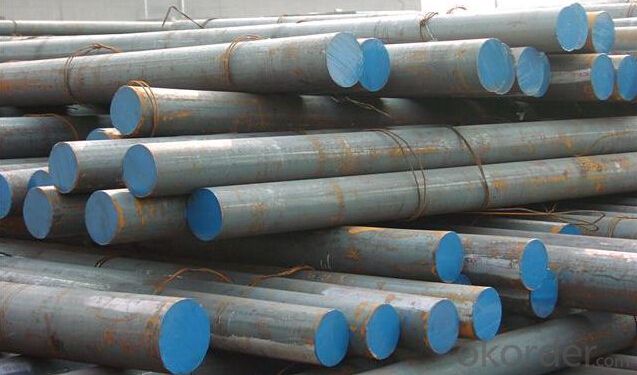
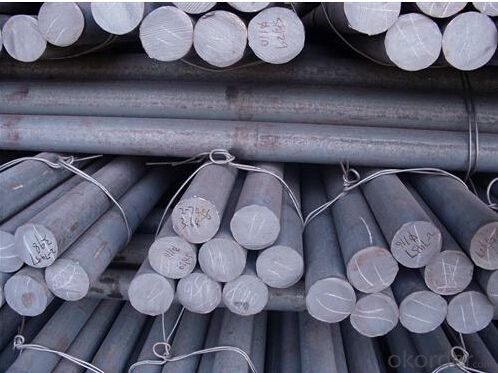
- Q:How does special steel perform under extreme temperatures?
- Special steel has been specifically engineered to excel in extreme temperature conditions. It boasts outstanding strength, hardness, and heat resistance, making it an ideal choice for applications involving extreme heat or cold. When exposed to high temperatures, special steel maintains its structural integrity, avoiding significant deformation or loss of strength. It also retains its hardness and dimensional stability, ensuring that it can withstand extreme conditions without compromising its performance. One of the key properties of special steel is its exceptional resistance to thermal expansion and contraction. This is particularly important when faced with drastic temperature changes. By expanding and contracting uniformly, the steel minimizes the risk of cracking or other types of damage. Furthermore, special steel exhibits remarkable heat resistance, allowing it to preserve its mechanical properties even at elevated temperatures. It demonstrates high creep resistance, which means it can resist deformation under constant stress in high-temperature environments. This ensures that the steel can endure prolonged exposure to extreme heat without experiencing failure or degradation. Not only does special steel perform exceptionally well at high temperatures, but it also excels in extremely low temperatures. It maintains its toughness and ductility, with minimal risk of embrittlement or cracking. This makes it highly suitable for cryogenic environments in industries such as aerospace or medicine. In conclusion, special steel has been specifically designed to outperform in extreme temperature conditions, offering impressive strength, hardness, and heat resistance. Its ability to maintain structural integrity, resist thermal expansion and contraction, and withstand high or low temperatures make it a dependable choice for various demanding applications.
- Q:What are the main factors that determine the cost of special steel?
- The main factors that determine the cost of special steel include the raw material costs, production techniques and processes involved, the complexity of the steel's composition, the level of customization required, and market demand and supply dynamics.
- Q:What are the safety considerations when handling special steel products?
- When handling special steel products, there are a few important safety considerations to keep in mind. Firstly, it is crucial to wear appropriate personal protective equipment (PPE) such as gloves, safety glasses, and steel-toed boots. This will help protect against potential injuries from sharp edges, heavy weight, or flying debris. Secondly, it is important to be aware of the weight and size of the special steel products being handled. Large or heavy items may require mechanical lifting equipment or assistance from others to prevent strain or injury. Additionally, it is necessary to inspect the special steel products for any defects or damage before handling them. This includes checking for cracks, fractures, or any other structural issues that could compromise their integrity. If any defects are found, they should be reported to the appropriate personnel and the products should not be used until they are deemed safe. Furthermore, special steel products may require specific handling techniques or tools. It is important to follow the manufacturer's guidelines and instructions to ensure safe handling. This may include using specialized lifting equipment, clamps, or supports to prevent accidents or damage. Finally, it is essential to have proper training and knowledge on how to handle special steel products safely. This includes understanding the weight limits of lifting equipment, knowing how to properly secure and stabilize the products, and being aware of any potential hazards or risks associated with the specific type of steel being handled. By following these safety considerations, the risk of accidents, injuries, or damage can be minimized when handling special steel products.
- Q:What are the different cutting tools used for machining special steel?
- Some different cutting tools used for machining special steel include carbide inserts, high-speed steel (HSS) end mills, diamond-coated tools, and ceramic cutting tools. These tools are designed to withstand the high hardness and heat resistance of special steels, ensuring precise and efficient cutting operations.
- Q:What are the main applications of special steel in the defense equipment?
- Special steel is widely used in defense equipment for its exceptional properties such as high strength, durability, and resistance to extreme conditions. Some of the main applications of special steel in defense equipment include the manufacturing of armored vehicles, tanks, submarines, and naval vessels. It is also used in the production of aircraft carriers, fighter jets, and helicopters, where its strength and resistance to corrosion are crucial. Additionally, special steel is utilized in the construction of ballistic protection systems, missile components, and firearms, enhancing their performance and ensuring their reliability in critical defense operations.
- Q:How is special steel used in the production of aircraft landing gear?
- Special steel is used in the production of aircraft landing gear due to its high strength, durability, and resistance to fatigue. It helps ensure the landing gear can withstand the stress and impact forces experienced during takeoff, landing, and taxiing. Additionally, special steel alloys are used to create components with precise dimensions and superior corrosion resistance, ensuring the landing gear performs reliably in various environmental conditions.
- Q:What are the main advantages of using special steel in the construction of bridges?
- The main advantages of using special steel in the construction of bridges are its high strength, durability, and resistance to corrosion. Special steel, such as high-strength low-alloy steel or weathering steel, can withstand heavy loads and extreme weather conditions, making it ideal for bridge construction. Its superior strength allows for the design of lighter and more cost-effective structures. Additionally, special steel's resistance to corrosion reduces maintenance and repair costs, ensuring the longevity and safety of the bridge.
- Q:Can special steel be used for making defense industry components?
- Indeed, the utilization of special steel in the production of defense industry components is possible. Special steel pertains to a classification of steel that has been deliberately designed and engineered to possess superior attributes and qualities when compared to standard steel grades. These attributes comprise high strength, exceptional toughness, resistance to corrosion, heat resistance, and wear resistance. Within defense industries, the materials utilized for components like armor plates, military vehicles, weapons systems, aircraft structures, and naval vessels must be able to endure extreme conditions while delivering optimal performance. Special steel, with its extraordinary attributes, fulfills these requirements and is frequently employed in the manufacturing of defense industry components. For instance, armor plates employed in military vehicles and personal body armor are commonly constructed from special steel alloys that can withstand ballistic impacts and safeguard personnel. Similarly, aircraft structures and naval vessels necessitate steel that can endure high stresses, corrosion caused by saltwater, and extreme temperatures, all of which can be accomplished through the use of special steel. Furthermore, the ease with which special steel can be machined, welded, and fabricated also contributes to its application in the production of defense industry components. This facilitates efficient production and assembly of intricate defense equipment. Overall, special steel is an essential material within the defense industry as it presents exceptional strength, durability, and performance attributes, rendering it an ideal selection for the production of defense components that must withstand rigorous and demanding conditions.
- Q:What are the main applications of special steel in the food packaging industry?
- Special steel is widely used in the food packaging industry due to its unique properties and benefits. It is primarily used for manufacturing various components of food packaging machinery, such as cutting blades, molds, and dies. The main applications of special steel in this industry include ensuring precision cutting, shaping, and forming of packaging materials, enhancing durability and resistance to wear and tear, and maintaining hygiene standards by preventing contamination and facilitating easy cleaning.
- Q:How does special steel perform in cryogenic gas environments?
- Special steel performs well in cryogenic gas environments due to its unique properties. It has excellent resistance to low temperatures and maintains its strength and toughness even at extremely cold temperatures. This makes it highly suitable for applications in cryogenic gas environments where traditional steel may become brittle or lose its strength. Additionally, special steel's resistance to corrosion and thermal expansion further enhances its performance in these extreme conditions.
1. Manufacturer Overview |
|
|---|---|
| Location | |
| Year Established | |
| Annual Output Value | |
| Main Markets | |
| Company Certifications | |
2. Manufacturer Certificates |
|
|---|---|
| a) Certification Name | |
| Range | |
| Reference | |
| Validity Period | |
3. Manufacturer Capability |
|
|---|---|
| a)Trade Capacity | |
| Nearest Port | |
| Export Percentage | |
| No.of Employees in Trade Department | |
| Language Spoken: | |
| b)Factory Information | |
| Factory Size: | |
| No. of Production Lines | |
| Contract Manufacturing | |
| Product Price Range | |
Send your message to us
Grade DIN34CrNiMo6(1.6582) Alloy Steel Round Bar
- Loading Port:
- Shanghai
- Payment Terms:
- TT OR LC
- Min Order Qty:
- 30 m.t
- Supply Capability:
- 10000 m.t/month
OKorder Service Pledge
OKorder Financial Service
Similar products
New products
Hot products
Related keywords
